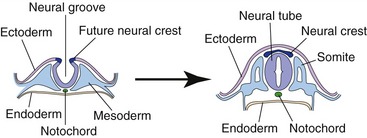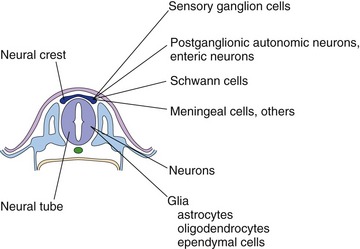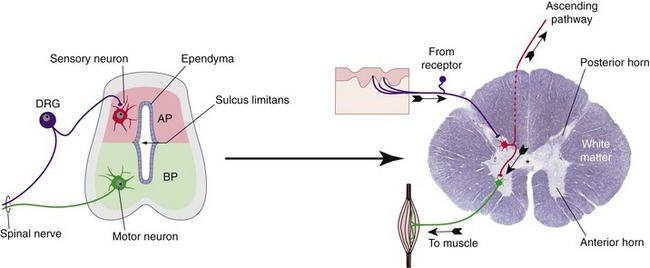2 Development of the Nervous System
The Neural Tube and Neural Crest Give Rise to the Central and Peripheral Nervous Systems
Cells of the neural crest grow at the apex of each neural fold. When the neural folds fuse to form the neural tube, the neural crest becomes a detached layer between the neural tube and the surface ectoderm (Fig. 2-1). Neural crest cells migrate from there, and go on to form most neurons and glial cells of the PNS (and much more). These include the sensory neurons of spinal and most cranial nerve ganglia, postganglionic autonomic neurons, and the Schwann cells of peripheral nerves and ganglia (Fig. 2-2). The neural tube goes on to form the CNS.
The Sulcus Limitans Separates Sensory and Motor Areas of the Spinal Cord and Brainstem
The sulcus limitans is a longitudinal groove that develops in the lateral wall of the embryonic spinal cord and extends into the rhombencephalon (the embryonic medulla and pons, as discussed a little later). It separates two groups of neuronal cell bodies, the alar plate (dorsal to the sulcus limitans in the spinal cord) and the basal plate (ventral to the sulcus limitans in the spinal cord). The alar and basal plates go on to become sensory and motor structures, respectively (Fig. 2-3). The spinal alar plate becomes the posterior horn, where primary sensory neurons terminate. The spinal basal plate becomes the anterior horn, where the cell bodies of motor neurons live.
The walls of the neural tube are spread apart in the rhombencephalon, forming the floor of the fourth ventricle, so in the medulla and pons the alar plate ends up lateral to the basal plate (Fig. 2-4). The same development into sensory and motor structures occurs, however, so cranial nerve sensory nuclei are lateral to cranial nerve motor nuclei in the adult brainstem (see Fig. 12-2).











